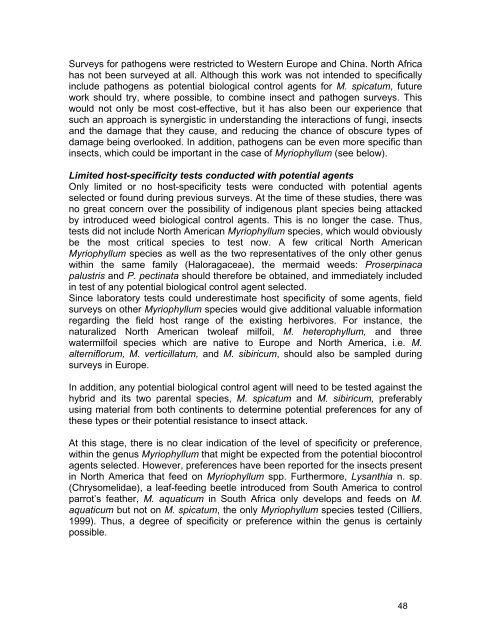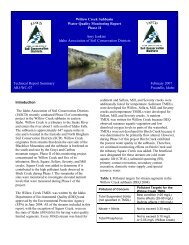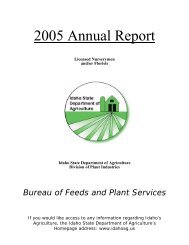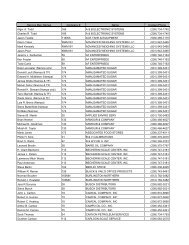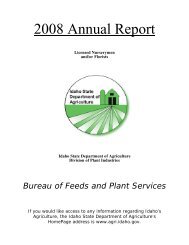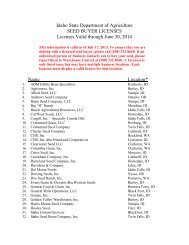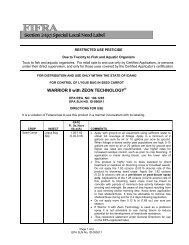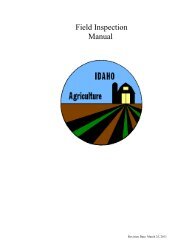2008 Statewide Strategic Plan for Eurasian Watermilfoil in Idaho
2008 Statewide Strategic Plan for Eurasian Watermilfoil in Idaho
2008 Statewide Strategic Plan for Eurasian Watermilfoil in Idaho
Create successful ePaper yourself
Turn your PDF publications into a flip-book with our unique Google optimized e-Paper software.
Surveys <strong>for</strong> pathogens were restricted to Western Europe and Ch<strong>in</strong>a. North Africa<br />
has not been surveyed at all. Although this work was not <strong>in</strong>tended to specifically<br />
<strong>in</strong>clude pathogens as potential biological control agents <strong>for</strong> M. spicatum, future<br />
work should try, where possible, to comb<strong>in</strong>e <strong>in</strong>sect and pathogen surveys. This<br />
would not only be most cost-effective, but it has also been our experience that<br />
such an approach is synergistic <strong>in</strong> understand<strong>in</strong>g the <strong>in</strong>teractions of fungi, <strong>in</strong>sects<br />
and the damage that they cause, and reduc<strong>in</strong>g the chance of obscure types of<br />
damage be<strong>in</strong>g overlooked. In addition, pathogens can be even more specific than<br />
<strong>in</strong>sects, which could be important <strong>in</strong> the case of Myriophyllum (see below).<br />
Limited host-specificity tests conducted with potential agents<br />
Only limited or no host-specificity tests were conducted with potential agents<br />
selected or found dur<strong>in</strong>g previous surveys. At the time of these studies, there was<br />
no great concern over the possibility of <strong>in</strong>digenous plant species be<strong>in</strong>g attacked<br />
by <strong>in</strong>troduced weed biological control agents. This is no longer the case. Thus,<br />
tests did not <strong>in</strong>clude North American Myriophyllum species, which would obviously<br />
be the most critical species to test now. A few critical North American<br />
Myriophyllum species as well as the two representatives of the only other genus<br />
with<strong>in</strong> the same family (Haloragaceae), the mermaid weeds: Proserp<strong>in</strong>aca<br />
palustris and P. pect<strong>in</strong>ata should there<strong>for</strong>e be obta<strong>in</strong>ed, and immediately <strong>in</strong>cluded<br />
<strong>in</strong> test of any potential biological control agent selected.<br />
S<strong>in</strong>ce laboratory tests could underestimate host specificity of some agents, field<br />
surveys on other Myriophyllum species would give additional valuable <strong>in</strong><strong>for</strong>mation<br />
regard<strong>in</strong>g the field host range of the exist<strong>in</strong>g herbivores. For <strong>in</strong>stance, the<br />
naturalized North American twoleaf milfoil, M. heterophyllum, and three<br />
watermilfoil species which are native to Europe and North America, i.e. M.<br />
alterniflorum, M. verticillatum, and M. sibiricum, should also be sampled dur<strong>in</strong>g<br />
surveys <strong>in</strong> Europe.<br />
In addition, any potential biological control agent will need to be tested aga<strong>in</strong>st the<br />
hybrid and its two parental species, M. spicatum and M. sibiricum, preferably<br />
us<strong>in</strong>g material from both cont<strong>in</strong>ents to determ<strong>in</strong>e potential preferences <strong>for</strong> any of<br />
these types or their potential resistance to <strong>in</strong>sect attack.<br />
At this stage, there is no clear <strong>in</strong>dication of the level of specificity or preference,<br />
with<strong>in</strong> the genus Myriophyllum that might be expected from the potential biocontrol<br />
agents selected. However, preferences have been reported <strong>for</strong> the <strong>in</strong>sects present<br />
<strong>in</strong> North America that feed on Myriophyllum spp. Furthermore, Lysanthia n. sp.<br />
(Chrysomelidae), a leaf-feed<strong>in</strong>g beetle <strong>in</strong>troduced from South America to control<br />
parrot’s feather, M. aquaticum <strong>in</strong> South Africa only develops and feeds on M.<br />
aquaticum but not on M. spicatum, the only Myriophyllum species tested (Cilliers,<br />
1999). Thus, a degree of specificity or preference with<strong>in</strong> the genus is certa<strong>in</strong>ly<br />
possible.<br />
48


